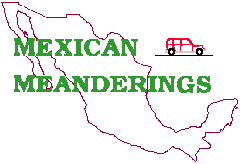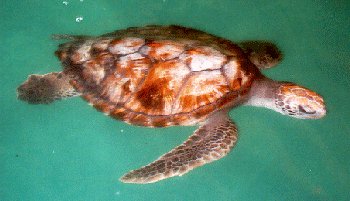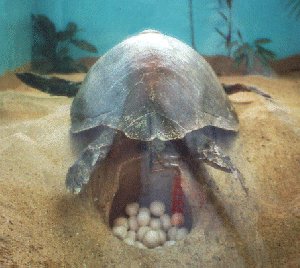Of Turtles |

|
Of Turtles |

|
Not all the world heeded the message simultaneously, nor reacted with the same gusto. Demand for sea turtle eggs, oil, meat and shell was difficult to placate. The creatures were easy to find and kill, and offered no danger to the hunter. The international fishing industry still accounts for a large annual number of turtle kills through entrapment and drowning in nets. Turtle excluding devices (TEDs) for fishing nets are costly, and the industry objects strenuously to this added outlay. Ongoing pollution of the seas includes untold quantities of plastic bags, which to turtle eyes seem to bear an uncanny resemblance to a staple of their diet, the jelly-fish. Ingested, the plastic blocks the digestive tract, causing starvation.
Since 1984, Mexican scientists have held inter-university symposia and conferences on the subject of the marine turtle. By 1990, these experts had accumulated sufficient evidence of the plight of these "armored fish" (the chimalmichin or ayotectli of the ancients) to convince their government to impose a total ban on their harvest. Mazunte, the former killing beach, was chosen in 1991 as the site for the Centro Mexicano de la Tortuga (CMT). Located about 7 miles west of Puerto Angel, this laboratory and aquarium is dedicated to the study, protection and preservation of the sea turtle. At the same time it serves as an educational site, providing both local residents and tourists alike with a greater knowledge of their environment and of these fascinating creatures.
The modern plant includes a large main building containing central and peripheral tanks devoted to examples of the seven species of marine turtles frequenting the Mexican Pacific, Gulf and Caribbean beaches. A small gift shop is also resident here. Outside, beneath protective roofing, are large tanks for the observation of both juvenile and adult individuals. Other areas are devoted to laboratories for the study of their diet, development and life habits. Teams of biologists and veterinarians are ably supported by technical staff and student interns. And for five days in June of 1995, the Center hosted the Twelfth International Conference on the Conservation of the Marine Turtle.
Although the CMT functions primarily as a marine turtle research center, it is also known locally as the "Turtle Museum," for here may also be seen examples of Mexico's six species of fresh water turtles as well as the two species of land turtles. You have to look closely to spot the latter; they are usually well hidden in the small cactus garden created for their benefit. And all of this may be seen Tuesday through Sunday from 9am until 6pm. It is closed to the public only on Monday.
So what is this creature called a turtle? Surely you've always heard of turtle steaks, turtle soup, and tortoise shell combs and other ornaments. But did you know that these came from a reptile? Certainly much more endearing creatures than, say, snakes or iguanas, but reptiles nonetheless.
Sea turtles have been around and recognizable for a long, long time, their fossils first appearing in rocks of the late Jurassic period, some 200 million years ago. During the course of the next 100 million years or so, one now extinct (thank goodness!) Late Cretaceous species attained a length of almost fifteen feet. He (or she) must have been truly formidable!
 | |
|
|
The eggs will incubate for some 6 to 10 weeks before the hatchlings break from the shell. Interestingly, their sex has been determined sometime after fertilization. Some experts believe sexual development may be a function of incubation temperature: warmer, more females or cooler, more males. Three or more days may be required for the three-to-four-inch hatchlings to dig their way to the beach surface. They usually break out at night and make their ungainly flight to the water, somewhat protected by the darkness from innumerable predators. Despite their numbers, scientists consider the survival rate to be very low. And little is known about where they go or what they do to survive during the next year or so.
 | |
|
on display at the Turtle Center |
The navigation system which enables these creatures to home in on their birth beach after several years and many hundreds of miles is a phenomenon shared by other seafarers (salmon for one) and aerialists such as swallows, monarch butterflies, etc. In the turtle, the capability is now thought to hinge on a metallic mineral in their brain which responds to the earth's magnetic field. Somehow the beach location is imprinted at birth or in the first few frantic hours or days of life before they embark on their lifelong voyage.
The above article comes from the newsletter Mexican Meanderings, published 6 times per year by
Co-Editors:
Subscriptions: $18 per year (USA), $20 per year (Foreign)
Other articles from the Mexican Meanderings newsletter are:
![]() Copyright
Copyright ![]() 1996
1996
![]() www.tomzap.com
www.tomzap.com
![]() Tom Penick:
tom@tomzap.com
Tom Penick:
tom@tomzap.com